 |
 |
 |
| | Home | People behind the Scenes | Koichi Takatsu | Part 2 Feelings About Noh Masks |
| |
|
|

![]() Part 1, Learning the Craft
Part 1, Learning the Craft
![]() Part 2, Feelings About Noh Masks
Part 2, Feelings About Noh Masks
![]() Part 3, In the Workshop
Part 3, In the Workshop
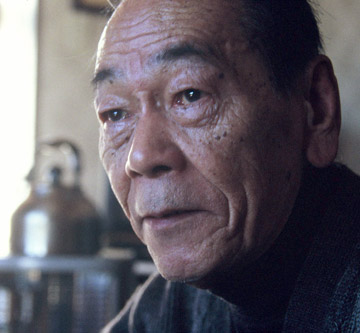 |
Photo: Toshiro Morita |
Part 2, Feelings About Noh Masks
On his profound feelings on Noh masks
It is impossible to truly understand the depths of Noh
--You must have some amazing thoughts on Noh masks. Could you share them with us?
Takatsu: When I’m making a mask, I feel strongly that I must complete my path on the road I have taken. But my feelings on Noh are a little different from moment-to-moment. I have seen many Noh plays I have been impressed with, but it’s not the beauty of the forms, but how the performers understand the essence of Noh and how they take on the persona of their characters, for example a ghost if they are playing ghosts, that is what I am really impressed by. You don’t see it as a stage then, but as a completely different world. That is when I feel that the depth of Noh is something that really can’t be understood.
With Noh masks also, for example, with five different ko-omote, the expression changes slightly with the mask maker and the performers. The more carefully you look at them, while the pattern looks the same, there is a depth and sense of wonder that doesn’t appear on the surface.
Noh masks are a symbol of the spirit
-- Looking back, what have Noh masks been to you?
Takatsu: Having made Noh masks for a long time, I feel like they are a symbol of the spirit. When I first encountered them, I had no idea what they were, and I found them unapproachably mysterious. But when I got to know them, I understood intuitively that Noh masks are an embodiment of the human spirit. The kanji for “statue” in “Statue of Buddha” really means to appear – in other words the Buddha appears to us. Noh masks also appear to us not as a human face, but as a human spirit. That is where the abstract nature of Noh lives.
Overwhelmed by the skill of ancestral Noh mask makers
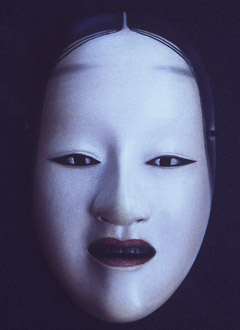 |
Zō (Photo: Toshiro Morita) |
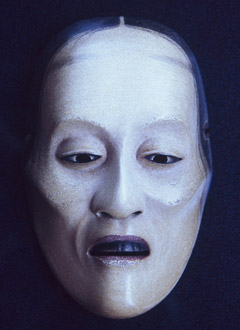 |
Yase-onna (Photo: Toshiro Morita) |
Takatsu: The appearance of Noh masks follow that of masks created by ancestral mask makers. If I were to make a mask in my own style and break from the traditional appearance, it would cease to become a Noh mask. For example if I were to make an Ono no Komachi mask in my own style, it would be completely different from the masks used on stage. Aside from specially ordered non-traditional masks, it would not be appreciated as a Noh mask. If non-traditional masks become popular, new masks may be born, but it is difficult. We are overwhelmed by the skill of previous Noh mask makers. There aren’t really any mask makers creating their own images. Honestly speaking, I would like to try it, but I’m not sure people would understand. It’s a difficult thing.
A true “Utsushi” (copy) is recreating a spirit
-- Noh masks are basically Utsushi, right?
Takatsu: Making a true Utsushi is not exactly easy. Some people think of Utsuhi as an exact duplicate. But true copies cannot be produced by hand. It is more about expressing the original feeling of the mask. While preserving the original form, I add my own subtle touches to the details of the mask.
If you get too attached to the idea of a “copy,” all of your focus is drawn to detailed measurement such as “the width or shape of the eyes.” When this happens you become separated from the task of making the mask. Using a stencil is convenient, but the stencil and not your own intentions make it hard to create a good mask. There is a saying, “carving a mask.” This means that you actually have to put your heart into a mask.
-- Put your heart into it...
Takatsu: I don’t want to sound conceited, but there are people who make Noh masks now by looking at photos or materials. For me, copying a mask means taking the original in my hand, looking at it carefully, and copying it. The person looking at a picture may think they could complete a copy, but they haven’t really.
-- So, being alike in appearance but quite different?
Takatsu: That’s right. That’s just a fun process. But real mask making means placing your own spirit and heart into your creation. I often wonder if I am placing enough of my heart into my masks. After having done this for a while, I wonder if these aren’t just simple creation, and whether that’s good enough.
The place of the nose determines everything
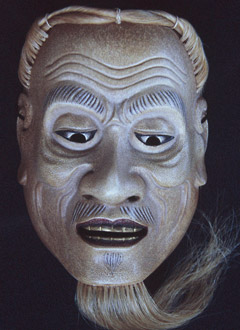 |
Ishiōjō (Photo: Toshiro Morita) |
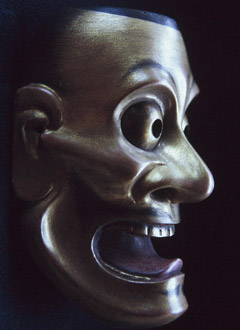 |
Ō-tobide (Photo: Toshiro Morita) |
-- What are some specific points that are important in creating a Noh mask?
Takatsu: The most important is the placement of the nose. Where you place the nose. The placement of the eyes and the mouth are determined by the nose. If the nose is just slightly too high, the eyes will become high, and the face will look distorted. This will affect the width of the face, which is created from there. And if the nose is too low, the chin will become short. There are some masks such as the chūjyō where the face is shorter than other masks. With those kinds of masks, one mistake can throw everything off.
The expression comes from the underside of the mask
-- Are there other points besides the position of the nose?
Takatsu: What you really have to understand to create well is the underside of the mask. The underside must be well formed in a Noh mask. When the actor puts it on, the fit is important, and attention must be paid to the underside, including details like directions of eyes. When the performer puts on the mask, they can see their beneath by drop their eyes through the nostrils of the mask. If the nostrils aren’t formed correctly, the actor cannot see below, and even if the nostrils open as a form, it doesn’t function as a prop. You’ll know it hasn’t been created by someone who understands masks. No matter how good the expression is, you can glimpse of the mask maker’s history from the underside of the mask. That’s quite obvious at a glance. What’s the most important with people is what’s beneath the surface. “Two sides of the same coin” ?
-- It’s interesting to learn that the underside determines whether the mask can be used in a performance.
Takatsu: The silhouettes of each face are different for each person. When the mask is placed on the face, it is adjusted to the silhouette of the face with Men ate (padding) made from cotton. However, a good mask can be worn on almost any face without being adjusted.
What I studied the hardest was the underside of the mask. So that the performers wearing the mask could concentrate more, I tried to create masks in a way that brought out their significance.
-- The more you study, the more the depth of the masks came out?
Takatsu: For example, I try to make them look like harshly when creating demonic masks, while I challenge to make them look like softly for masks of women. Those depend on what the mask maker feels at that time. This doesn’t mean it must be rough and sloppy, but you think about the direction of the knife as well as creating the mask so the underside also has expression.
Some things become visible with “Riken no ken” (seeing with detached perception)
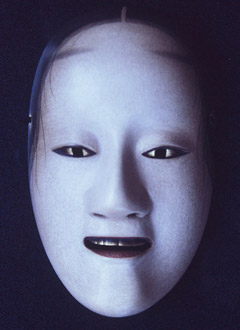 |
Deigan (Photo: Toshiro Morita) |
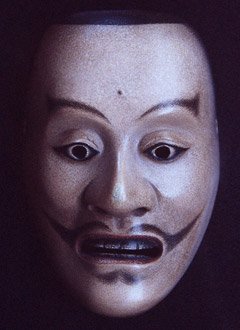 |
Heida (Photo: Toshiro Morita) |
-- Is there a special mindset you approach mask making with?
Takatsu: I don’t take mask making that seriously. People may think that it is a special job that requires a particular meticulousness, and that I start early in the morning and make masks all day. I give myself time to while doing daily activities, and try to envision what I am going to make next. But once I start making a mask I will sit down all day.
I start work fairly late, getting to the workshop at around 10am, and keep working until I am satisfied, at the latest until 9-10pm. That seems like it would be tiring, but once I start, I never think “I’ll work until here today.” But sometimes when I finish my work with satisfaction and come down to the workshop the next day, I’ll realize “I spent all that time yesterday doing nothing.” Even after practicing this for dozens of years, I still don’t really have control over what I create. It depends on what I’m feeling now.
-- So it’s a day-to-day fighting in all seriousness?
Takatsu: That’s right. As Zeami advocated it as “Riken no ken” (seeing with detached perception), you have to be able to look at your own creations objectively. Sometimes, I am dedicated too much to afford to think calmly. Only delving further into my work, I somewhat lose the objectivity. On the next day, I realize with just one glance. I’m wondering myself.
Creating masks for posterity while feeling the change in the times
-- What is your goal now?
Takatsu: When looking at masks created by my predecessors, good masks stand up to use and last. I always ask myself what I have done. I have concluded that it is better to pass my work down the generations by assessing from posterity, not current generation. Concentrating into mask making, I would like to create one or two masks that will continue to be used in the future. That’s how I feel now.
100 years or later, how differently will people think matters? This difference in the thinking style is just the difference in the times. Masks made in the Edo era are much different from the masks we make now. Even masks with the same name have a completely different spirit. Making masks now in the age of information compared to making masks in silence by the light of one candle. Now we have electricity and can work whenever. On the other hand, our predecessor took just one step they would be covered in darkness. That difference in the mindset of the people of the time is reflected in the masks.
-- So that is reflected in the masks, even though their traditional form is preserved?
Takatsu: Having facing masks for dozens of years, I feel the depth of expression in old masks is completely different from new one. Even trying to duplicate that is impossible. Historical backgrounds are completely different. All I can do is my best to approach work seriously and focus on my creations in the age I live in.
In my 20s, even though there weren’t many people watching Noh, there were Noh masters who gave wonderful performances in which they became one with their masks. The audiences were small but sophisticated, and they challenged each other to create a wonderful world of theater. Living in that challenging world allowed me to learn.![]()
| Terms of Use | Contact Us | Link to us |
Copyright©
2024
the-NOH.com All right reserved.